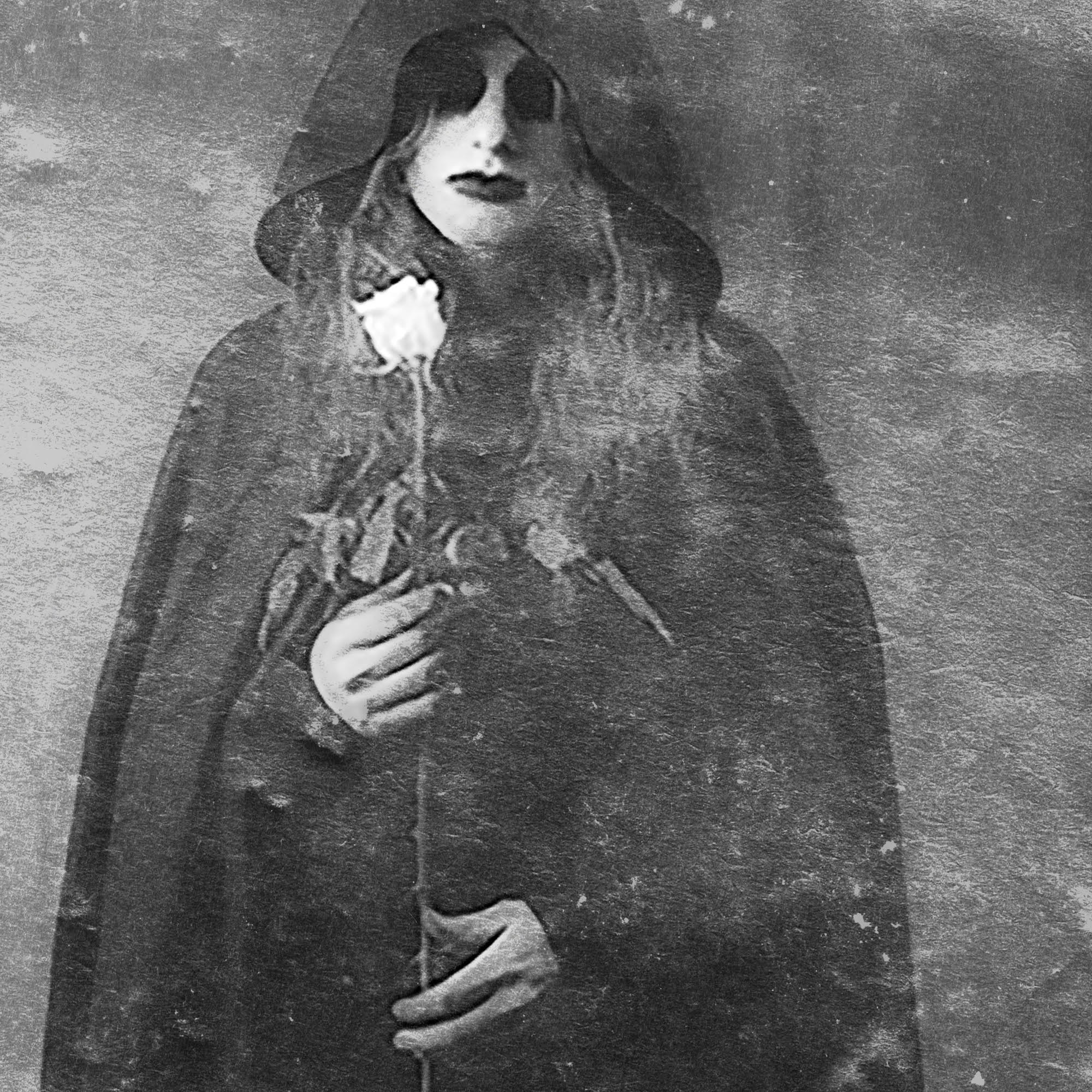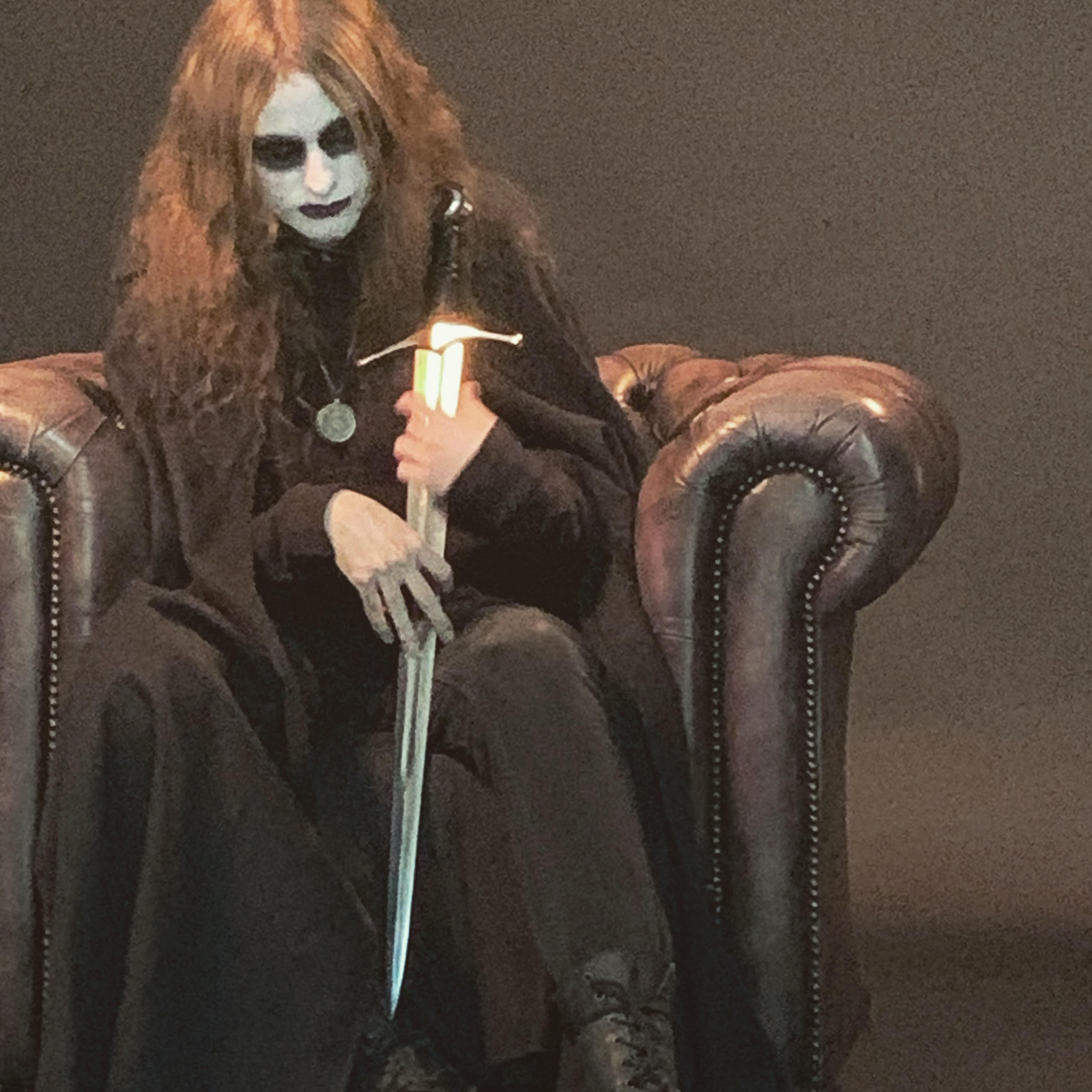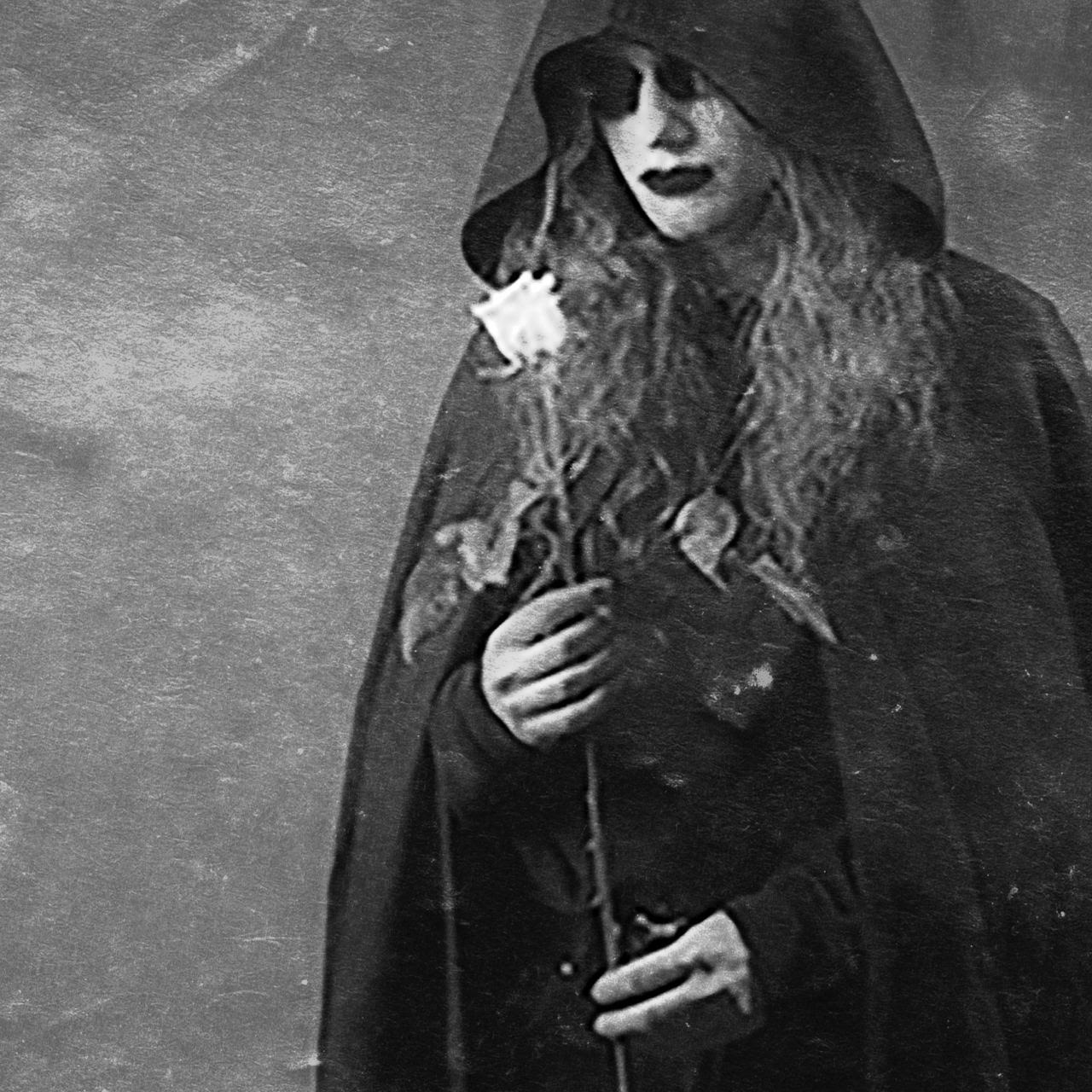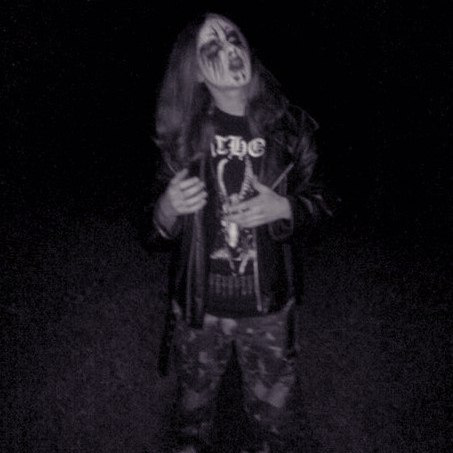Interview with Këkht Aräkh
5/19/21 | C.C.

Longing and loss form a large part of Këkht Aräkh’s musical worldview. The Ukranian artist behind Pale Swordsman can be read as a night-dwelling enigma. A vampire perhaps, who needs to journey through lightless lands to their final destination, a castle that encloses what is deeply hungered for yet seems eternally unattainable. Black metal with a gothic slant is not a new trend but introducing tropes of love is certainly a unique take in the raw black metal world. The vampiric element is one that we are hearing more of in the current USBM scene, yet the way it is used on Pale Swordsman is to render the emotional side more tangible rather than playing with the unknown.
The sadness that peers through the instrumental strokes of “Amor” or the ballad that closes the record with beautiful clean vocal lines is one that many of us have felt and Këkht Aräkh takes that human aspect and twists it around the folklore of the undead. There is an honesty here that is powerful and while sole member Crying Orc is somewhat reticent to allow us a deeper look into their thoughts, only giving clarity when it feels appropriate, listening to Pale Swordsman may grant a glimpse into the anguish that has inspired this incredible record. Strength and vulnerability are given equal weight while the sense of the other is woven carefully through the textures of the songs as a magical element reveals itself as the album progresses through anger, acceptance and relief.
There is still much left to decipher in the world of this Swordsman and where clouds cover the moon there is cast a shadow and for Këkht Aräkh that metaphor strikes true — questions are left open to interpretation as are the songs on Pale Swordsman. Its narrative flows along the pathway of its protagonist coming closer to that which will quench their thirst, giving themselves over to a higher power, cleansing themselves by the light of the moon to obtain peace through the ultimate sacrifice.
Here, Crying Orc explains some of what drives him to create this romantic, gothic black metal while still keeping much of himself cloaked in the shadows, as is befitting for the creator of a record that wants to wrap itself in mystery and darkness.
How did you start your musical journey and specifically getting into black metal? Have you played in bands prior to this?
I started learning music at the age of seven. My mother sent me to musical school where I started learning piano and then guitar along with a bit of musical theory.
I got into black metal when I was 13-14 or so. It happened after I first heard Burzum's ‘Dunkelheit.’ The selling point for me was that it somehow felt detached from all the metal music I'd been listening to. I was always alone in my musical activities due to the lack of soulmates here. And the only metal band I used to play with was Cuckoo's Nest. But since I got down to Këkht Aräkh more seriously, I decided to quit all the side activities.
How did the name Këkht Aräkh come to be?
Këkht Aräkh is the same play of Yin and Yang that can be traced in my concepts here and there. I [have made] a post on the project's Insta explaining the origin of the name and it says the following:
‘Actually, there is no specific meaning. Name is just composed of two words that are references to two totally different mythological characters. The first one “Këkht” references to Irish god of healing — Dian Cécht. And the second one “Aräkh” was taken from Cambodian poisoning god — Arak Kol (I’m not sure about the spelling). Word “arak” itself stands for “evil spirit (usually female)” in Cambodian mythology.’
When I was coming up with a name for the project back in 2018, I wanted it to reflect the idea of being sheltering and healing, but still evil and aggressive. So here we have “Këkht Aräkh” in result.
Also, for those who're wondering about how it's to be pronounced, I think I can interpret it as “Kecht A-rock.”
How did you come up with the pseudonym of “Crying Orc?” That is quite an evocative name and one that sparks a great deal of interest. This is the name of a Burzum song which of course brings a great deal of questions as to why you would choose such a reference. Can you explain your reasoning behind this? Initially I had the thought of something completely different which is the strength and power of the Orc yet the sadness that is implied by the tears, as I hadn’t made the connection at first. Is this a reflection of having two sides, of the feeling of finding strength through vulnerability?
It was so damn long ago so I can't even remember more precisely haha. But yeah, just as you said, the point was about the combination of both strength and something fragile.
Obviously, the alias was taken from Burzum's "The Crying Orc", but since I knew nothing about the song's background back then, I perceived the title my own way.
It was something familiar to my own nature. I'm getting emotional or sentimental about things easily, but still I have a bunch of strong sides about my temper.

You’re treading a more romantic side of black metal, songs that are, on the surface, about love and lost love, wandering to find that again—would you say that you are romantic at heart? Why do you think that this is a style that you felt drawn to and how did you decide to then merge it with some of the characteristics of the early Norwegian sound?
I think I am romantic to some extent, yes. But it's not only about love in the meaning we're used to. I always think deep about things in the world, about good and bad. About senseless evil we face here and there. Either this something about our human life, or about more primal things that happen in nature as something for granted.
And pure love and happiness which can't be reached while in this world, so they take place only in our fantasies. Such a tragedy that I can't take, works as a main fuel for my creativity. And [the] vibes that those old Norwegian bands' music brings up, suit this mood of mine.
There are a lot of repeated motifs on Pale Swordsman—the use of “wandering in the night pale swordsman” as a lyric or “seven blades.” Perhaps “Crystal” and its mirror image of “Forever Night Castle of Love” from the previous album, Night & Love. Is it important to you to have these anchors in the music?
Yes, I like when there are some certain repetitive images in artists' concepts that can be traced throughout all of their works, as it happens to Current 93 for instance. It's like creating your own universe.
By the way, ‘Seven Blades’ was a reference to a certain icon of Holy Mary that's being used in orthodox christianity. Going by biblical concept, number of seven means completeness of something. Those seven blades on the icon represent all the hardest hardships Mary endured throughout her life.
Is religion something that you’ve adhered to in the past or had a relationship with? How has that changed over the years?
My mother is a very religious person, so I was growing up surrounded by religion here and there in my life. And now it just takes a special place in my heart.
Using the seven blades reference, do you feel some kind of kinship with Mary in terms of hardships she had or that you’ve had in your life?
In the context, ‘Seven Blades’ represents [the] torment of the protagonist, Pale Swordsman, which he carries throughout his living. But I'm not going to get into the concept any further. I'd like to let people interpret it the way they feel like.
There’s an analogue hiss that is present throughout Pale Swordsman, it gives the record a feeling of being grounded, there’s a sense of the fallible nature of being human, no one is perfect. How intentional was this and how did you create that sound?
It was one of the ways to make the record more warm, calming and holistic. I don't feel like going into technical details, because in my opinion it ruins the magic.
The bass sounds really rich at times, very present (“Amor,” for example) and the drums have a punk tone to them that a lot of newer raw black metal bands seem to have, maybe as a homage to a lot of music the artists grew up listening to. Is that the case for yourself?
I brought the bass to the front to have more space for dynamics without complicating the whole composition. I love to keep things as simple as I can.
Also I'd like to point out that I recorded the drums myself for Pale Swordsman and didn't do the programming as some people seem to think. I quit doing drum programming after Night & Love.
The difference between Night & Love and Pale Swordsman is quite obvious in that the latter record feels more... structured, that the flow is more deliberate and the ambient tracks are more direct. Night & Love is a great record however the obvious step up for Pale Swordsman comes in the honing of the tracks to be less overwhelmed with sounds and ideas. Have you been quite strict this time around in order to create something more in line with your vision?
The initial idea of the project regarding music was to make something compact, minimalistic, coherent and easy to perceive. With Pale Swordsman I think I just got closer to the idea.

How important is the visual aspect? Particularly the album cover or the cover for the “Thorns” single release. It’s a very expressive reflection of what the music actually is. Romantic, lonely, longing. The black-and-white colouring is also stark and cold, in a way. Do you feel that the artwork has to reflect the music within?
Sure. I pay a lot of attention to the visuals, because it makes the part of work in perceiving an album by a listener. Not even have to say that cover sets the very first impression about an album.
Just imagine how your impression about Transilvanian Hunger would be if it had a cover looking like a Dimmu Borgir one.
Was it a conscious choice to play against what might be expected for “raw” black metal and use flowers and gothic imagery for the album cover and “Thorns” single?
I don't think it was any conscious at the beginning. At first I just wanted to share my own vision of black metal, but then it just became some kind of project's feature.
It turns out rather naturally than consciously, because there are some things in black metal that I can associate with myself, but also there are some that I can't, so I just replace those ones with something [of my own].

You often have moments of high emotion—“Swordsman” on this record, where the blackened aspect is completely stripped away and the ballad-like nature of the songs is able to shine through. Do you write with this in mind or do you allow the songs to form as you’re recording them, into these simpler tracks with a big impact?
It seems to me that this has become something of a characteristic feature of the project. When I was working on the very first project's demo Through the Branches…, I was thinking about how to musically highlight the upper-mentioned duality of the project without resorting to cross-breeding black metal with clean singing and stuff the way bands like Shining do.
So in result I have the demo split in two different moods following the same concept. I did pretty much like the idea of how black metal transits into something calm and gentle, so I decided to play around and expand the idea on my further projects.
Also keeping clean-singing ballads separate from the actual black metal content works good for those people who don't like the idea, so they can just skip the track.
What do you envision for Këkht Aräkh in the future?
Ummm...I don't think I have any certain plans for the future. Only thing is that I'd really like to increase the quality of the sound. It doesn't mean that I want to polish it, but just make the songs more coherent, put more resources into recording and mixing, and better lo-fi stylization.
Me and Livor Mortis can make it happen now thanks to the people supporting the project.



